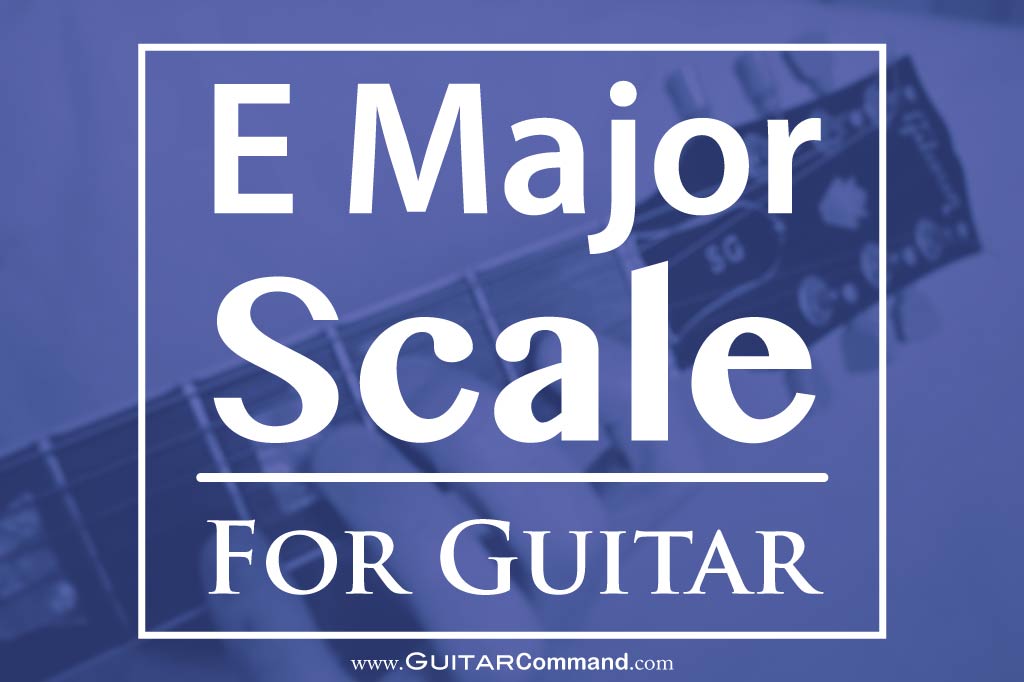A complete guide to playing the E major scale for guitar. On this page you’ll find E major guitar TAB, notation, and scale patterns / fretboard diagrams for electric, acoustic and classical guitar.
Page Index
- Intro & Tips
- 1 and 2 Octave Open Position E Major Scales
- 1 Octave E Major Scale Further Up The Neck
- Another 2 Octave E Major Scale For Guitar
- 3 Octave E Major Scale TAB
- E Major Scale For Guitar Scale Pattern
- 2 Octave E Major Scale Using Pattern
- Notes In The E Major Scale
- E Major Scale For Guitar: Conclusion
- Useful Links
Relevant Pages Elsewhere On Guitar Command
- Play any major scale anywhere on the guitar neck: Major Scale Guitar
- Guitar scale patterns and how to use them: Guitar Scale Patterns
- Info on guitar TAB and how to read it: How To Read Guitar TAB
- The ultimate online guitar scale reference: Guitar Scales
- Master the guitar neck: download our comprehensive Guitar Scales Chart Book: Guitar Scales Chart Book
- Practice improvising using a variety of scales: Guitar Scales Backing Tracks Albums
E Major Scale Guitar: Introduction
As with many things in guitar playing, there are several different ways of playing a E major scale on guitar.
Most notes on the guitar can be played in at least two places on the fretboard. For example, the E produced by playing the open (top) E string can also be played at the 5th fret of the B string.
For this reason there is often more than one way of playing a particular scale on the guitar, and the E major scale is no exception.
On this page you'll find notation and TAB for playing one, two and three-octave E major scales using a variety of fingerings.
Beginners should start with the 1 octave open position E major scale before progressing to the other scales on the page.
You’ll also find a major scale pattern that can be used not only to play a E major scale, but also every other major scale, simply by moving the fretting hand to different fretboard positions.
- Additional major scale patterns can be found here: Major Scale Guitar
Scale Playing Tips
When playing guitar scales, aim for an even tone and tempo. It is highly beneficial to practice scales with a metronome. Start slowly and only increase the tempo when you can play the scale smoothly, clearly and evenly.
1 and 2 Octave Open Position E Major Scales
1 octave E major scale guitar TAB showing the scale being played in open position. (Recommended left hand fingering has been provided.)

You can also play a 1 octave E major scale starting from the open bottom E string, as shown in the TAB below:

You can combine the above scales to play a 2 octave E major scale in open position, as shown in the TAB below:
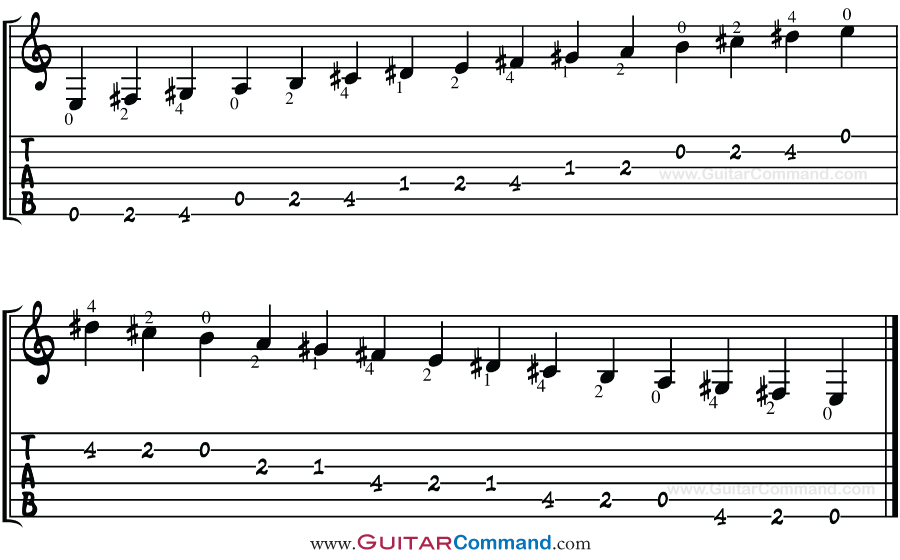
1 Octave E Major Scale Further Up The Neck
You can play an E major scale at many positions on the fretboard. Below is a one octave scale played in 4th position.

The Roman numerals above the notation show the fretboard position at which the notes should be played; ‘II’ means position your fretting hand so that the index finger is ready to play at the 2nd fret, ‘I’ means position your fretting hand so that the index finger is ready to play at the 1st fret.
Another 2 Octave E Major Scale For Guitar
An alternative way of playing a 2 octave E major guitar scale is shown below. Although the notes of the first octave of the scale are exactly the same as those of the first 1 octave open position scale, they are all played at different frets.

3 Octave E Major Scale TAB
Playing a 3-octave E major scale requires a number of fretboard position changes. Keep an eye on the Roman numerals (or follow the TAB) to make sure you're playing at the correct fretboard position.
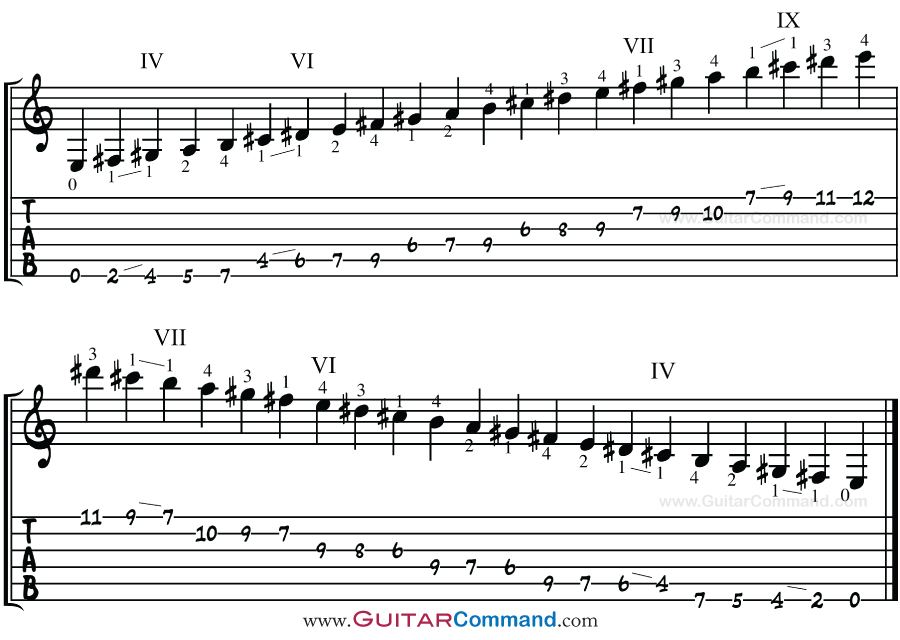
E Major Scale For Guitar Scale Pattern
Below is a pattern for playing a E major scale starting at the 12th fret of the low E string. Although this can be played on acoustic and classical instruments, it's most suited to electric guitars which generally have better access to higher frets.
- You can find out how to read scale patterns on this page: Guitar Scale Patterns
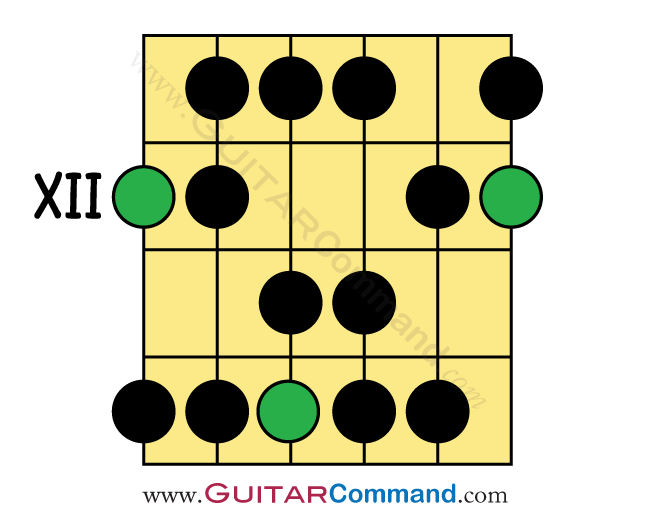
In the pattern above, the tonic notes of the scale are represented by green circles. The other notes of the scale are represented by black circles.
(The tonic notes of a scale are the ‘name’ notes of the scale, i.e. the ‘C’s in a C major scale, the ‘D’s in a D major scale, etc.)
Play a one-octave scale by starting from the lowest green note and stopping at the next green note. Play a two-octave scale by continuing to the highest green note, as shown in the TAB below.
2 Octave E Major Scale Using Pattern
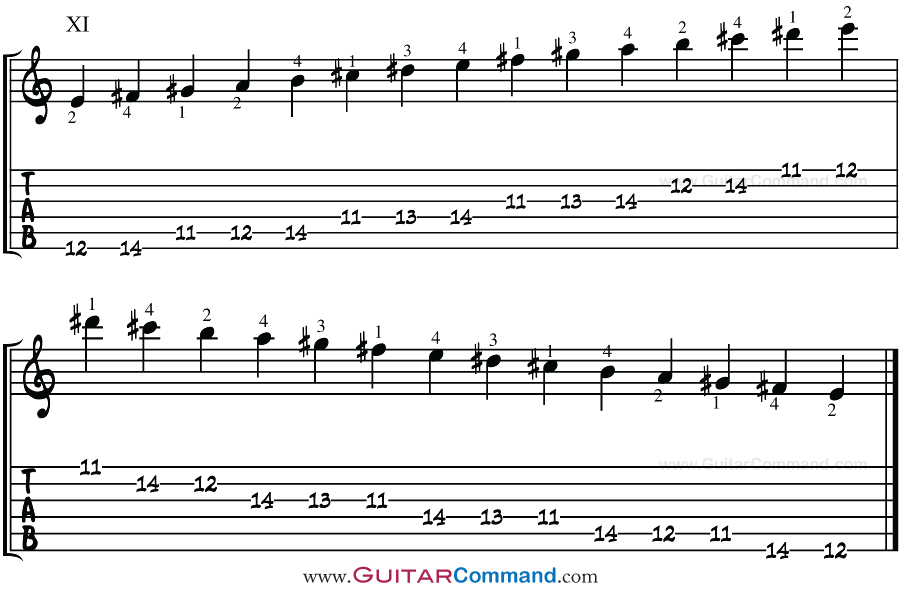
- You can find more scale patterns for playing major scales on this page: Major Scales On Guitar
The beauty of movable scale shapes is that once you've learned one shape, you can move it to different fretboard positions in order to play other scales.
For example, by moving the above pattern 2 frets down (i.e. starting at the 10th fret of the bottom E string instead of the 12th fret), and keeping all the fingers in the same position relative to the new starting note, you’d be playing a D major scale.
Likewise, by playing the pattern in 4th position (i.e. starting with the A at the 5th fret of the bottom E string), you’d be playing an A major scale.
By learning just one pattern, you can quite literally play every major scale! However, most guitarists learn more than one shape for each scale so that they are not restricted to playing the scale at a particular position on the fretboard.
- You'll find additional patterns for playing major scales on this page: Major Scale Guitar
Notes In The E Major Scale
The E major scale, like all major scales, is heptatonic, which means that it contains seven notes before repeating again at the octave.
The notes in a E major scale are: E, F#, G#, A, B, C#, D#, E (Octave)
The E major scale contains four sharpened notes: F sharp, C sharp, G sharp and D sharp.
E Major Scale For Guitar: Conclusion
We hope that you've found everything you need on this page in order to be able to play a 1, 2 and 3-octave E major scale on your guitar.
If you have any questions on playing this scale then feel free to ask them in the comments section below; we’d be happy to help. We also welcome any comments or suggestions on how we can make this page even more helpful!
Check out the links below for more guitar information...
Useful Links
- For the ultimate online guitar scale reference, visit this page: Guitar Scales
- For a useful overview of major scales, including several additional scale patterns and TAB examples, see this page: Major Scale Guitar
- To find out more about guitar scale patterns and how to use them, see this page: Guitar Scale Patterns
- For information on guitar TAB and how to read it, visit this page: How To Read Guitar TAB
- You can download a comprehensive printable guitar scale book here: Guitar Scales Chart Book
- Practice improvising using guitar scales with our specially-produced backing tracks: Guitar Scales Backing Tracks Albums

